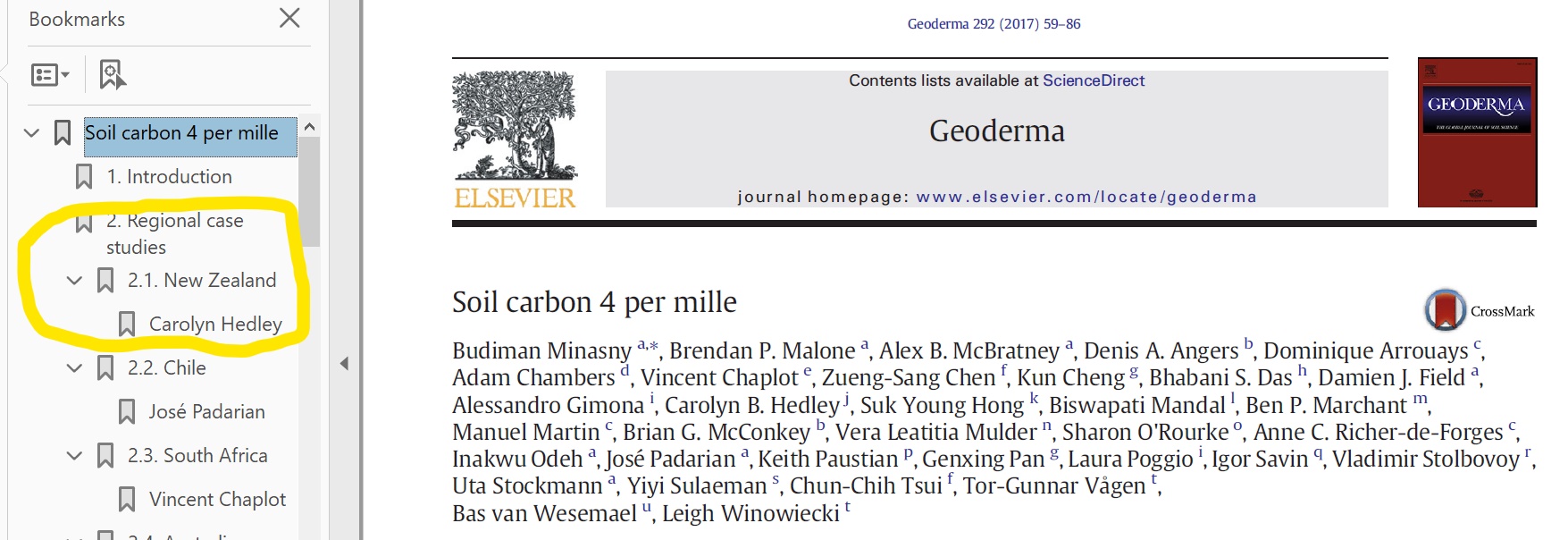Dr Carolyn Hedley from Landcare Research has contributed to the above report, dated April 2017. We did not hear much from the past government on their (any) commitment to 4per1000. I’m keen to find out more on where NZ is going with this commitment. Which branch of govt is dealing with this?
When you search the full report, biochar is only mentioned by NZ, China and USA, but still not a major focus. I think new information now being reported can change this.
Soil carbon 4 per mille
2.1. New Zealand
“The estimated mean SOC stocks in New Zealand are 98.7 t C ha−1 to a depth of 0.3 m (Fig. 3). To meet the 0.4% initiative, New Zealand will require a SOC sequestration rate of approximately 0.4 t C ha−1 year−1. The New Zealand Ministry for the Environment (MfE) established the Soil Carbon Monitoring System (Soil CMS) for annual reporting on the land use, land-use change, and forestry (LULUCF) sector in the national greenhouse gas inventory, submitted to the United Nations Framework Convention on Climate Change (UNFCCC). This system provides evidence for larger SOC stocks in long-term pastoral soils compared with established forest land (New Zealand Ministry for the Environment, 2015). Therefore, land use change from forest to pasture sequesters soil carbon over a period of decades. However, there are limited opportunities to convert more forest land to pasture, and this conversion would need to account for the loss of biomass C, making this option less favorable.
Current challenges are to maintain or enhance already high levels of SOC stocks in New Zealand’s productive grazed pastoral soils, as well as find other practical ways to sequester C into soil. The peaty soils associated with our vegetated wetland areas have the largest SOC stock at an estimated 136.06 t C ha−1. However, when drained for productive use they rapidly lose SOC through oxidation of the organic matter, estimated at a rate of 2.94 t C ha−1 year−1 (Campbell et al., 2015). Thus establishing or restoring wetlands can contribute to SOC accumulation. These wetlands could be established in areas otherwise unsuitable for productive agriculture, e.g. high country and floodable areas.
Work undertaken to assess erosion impacts on SOC for LULUCF reporting found that landslides cause a significant net decline in soil C stocks, with eroded sites only recovering to 70–80% of original levels. However, rates of soil carbon accumulation in recent erosion scars have been measured at 1–3 t C ha−1 year−1 for the first 10 years, and 0.4–1.1 t C ha−1 year−1 over a 70-year period (Lambert et al., 1984; De Rose, 2013; Basher et al., 2011). These studies provide useful data on potential rates of SOC sequestration when degraded land rehabilitates to pastoral land use.
SOC stock-change trajectories in long-term managed grasslands have been investigated by resampling some flat pastoral sites previously sampled about 30 years earlier, and the study reported small SOC stock losses at these selected sites (n = 125; Table 1). However, a study by Parfitt et al. (2014), using a different subset of flat pastoral sites as part of a regional soil quality monitoring program, reported increasing SOC, with change rates between 0.32 ± 0.19 t C ha−1 year−1 and 0.57±0.31 t C ha−1 year−1, for dairy and dry stock flat land respectively (n=139). Both researchers observed increasing SOC stock at a small number of stable positions in the hill country (n=19–23); with possible reasons given being: reduced overgrazing, and/or a gradual longterm recovery of soil organic matter following erosion when forests were originally cleared.
Parfitt et al. (2014) linked changes in SOC to soil pH and P fertility, finding the sites they resampled that had decreased in pH had significant gains in C,whereas sites that had increased in pH had no significant gains in C,with possible reasons being that high pH (due to liming) and increased P fertility indicate more intensive management, thereby reducing SOC. Alternatively, there could be enhanced relocation of dissolved organic carbon to greater depths in soils of lower pH.
- Percival et al. (2000) showed a positive relationship of SOC content to pyrophosphate-extractable Al, Fe oxide, allophane and clay content in New Zealand soils. Current research topics (http://www.nzagrc.org.nz/soil-carbon.html) on ways to sequester C include:
• assessing the gap between current and potential levels of carbon storage in New Zealand soils
• assessing the effect of the more frequent renovation of dairy pastures, and mixed sward compositions.
• assessing the effect of biochar additions to soils, including the economics of incentives for land managers to apply biochar to land.
In conclusion, SOC in New Zealand soils is naturally high. Opportunities to sequester SOC include the creation or re-establishment of wetlands, and land use change (taking into account any impacts on biomass C). Current knowledge suggests that ways to sequester SOC will include targeting specific soil classes (e.g. allophanic soils), and/or specific landscape positions (e.g.wetlands) and using appropriate management strategies.
Efforts by landowners to sequester carbon into soil will need to be supported by improved ways of monitoring change, and New Zealand will need to develop a purpose-built sampling and monitoring protocol to address this challenge.”
For more on the 4per1000 initiative: https://www.4p1000.org/governance
